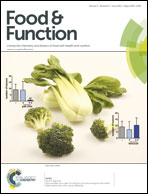Chalcones suppress fatty acid-induced lipid accumulation through a LKB1/AMPK signaling pathway in HepG2 cells
Abstract
Excessive lipid accumulation in the liver has been proposed to cause hyperlipidemia, diabetes and fatty liver disease. 4-Hydroxyderricin (4HD), xanthoangelol (XAG), cardamonin (CAR) and flavokawain B (FKB) are chalcones that have exhibited various biological effects against obesity, inflammation, and diabetes; however, little is known about the inhibitory effects of these chalcones on fatty liver disease. In the present study, we investigated the ability of 4HD, XAG, CAR, and FKB to reduce lipid accumulation in hepatocytes. When HepG2 cells were treated with a mixture of fatty acids (FAs; palmitic acid : oleic acid = 1 : 2 ratio), significant lipid accumulation was observed. Under the same experimental conditions, addition of chalcones at 5 μM significantly suppressed the FA-induced lipid accumulation. We found that the expression of sterol regulatory element-binding protein-1 (SREBP-1), a key molecule involved in lipogenesis, was decreased in these chalcone-treated cells. We also found that these chalcones increased the expression of peroxisome proliferator-activated receptor α (PPARα), which is involved in FA oxidation. Moreover, these chalcones increased phosphorylation of AMP-activated protein kinase (AMPK) and liver kinase B1 (LKB1), upstream regulators of SREBP-1 and PPARα. We confirmed that an AMPK inhibitor, compound C, reversed chalcone-induced changes in SREBP-1 and PPARα expression in the HepG2 cells. Collectively, we found that 4HD, XAG, CAR, and XAG attenuated lipid accumulation through activation of the LKB1/AMPK signaling pathway in HepG2 cells.


 Please wait while we load your content...
Please wait while we load your content...